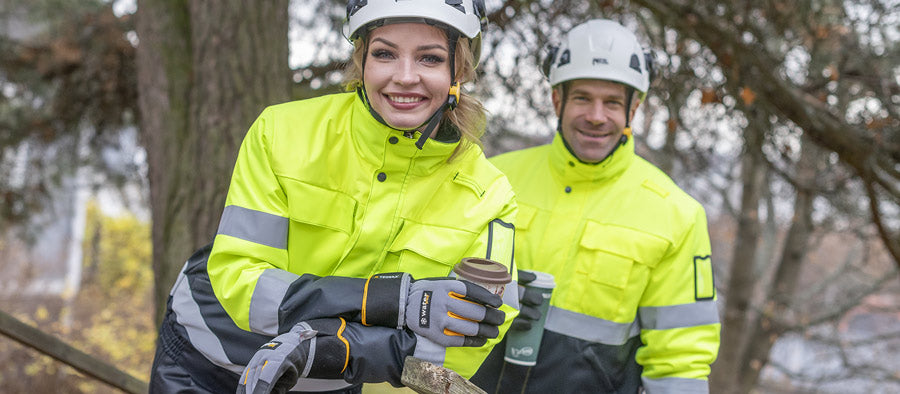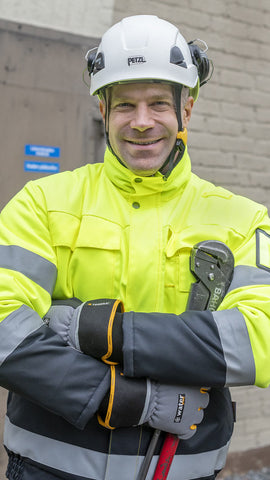Work clothes for winter and cold protection standard EN 342:2017
 With the right winter work clothes, you can defy the cold, wind, and sleet. You can't control the weather, but you can decide what to wear. "There is no such thing as bad weather, only wrong clothes." A cup of hot drink and blowing warm air on your hands can make it easier for a while, but work clothes designed for winter weather are like choosing the right tool - try to fasten a screw with a coin or a knife. The proper quality workwear is a worthwhile investment for winter weather. It protects and reduces the risk of illness and make work safer, more comfortable, and more efficient.
With the right winter work clothes, you can defy the cold, wind, and sleet. You can't control the weather, but you can decide what to wear. "There is no such thing as bad weather, only wrong clothes." A cup of hot drink and blowing warm air on your hands can make it easier for a while, but work clothes designed for winter weather are like choosing the right tool - try to fasten a screw with a coin or a knife. The proper quality workwear is a worthwhile investment for winter weather. It protects and reduces the risk of illness and make work safer, more comfortable, and more efficient.
 One of the most important features of winter work clothes is to provide adequate warmth for the entire working day. The goal is therefore not maximum, but optimal thermal insulation. The physical load of the work affects the need for thermal insulation. The more you are moving around during the working day and the more physically demanding your work is, the lower the need for thermal insulation. If the garment is too warm for work, it will get wet when you sweat. Damp clothing provides less protection against the cold than dry clothing. If, on the other hand, you work in a physically light job in very cold conditions, the clothing must be warmer. Wind increases the need for heat insulation and wind protection.
One of the most important features of winter work clothes is to provide adequate warmth for the entire working day. The goal is therefore not maximum, but optimal thermal insulation. The physical load of the work affects the need for thermal insulation. The more you are moving around during the working day and the more physically demanding your work is, the lower the need for thermal insulation. If the garment is too warm for work, it will get wet when you sweat. Damp clothing provides less protection against the cold than dry clothing. If, on the other hand, you work in a physically light job in very cold conditions, the clothing must be warmer. Wind increases the need for heat insulation and wind protection.In addition to thermal insulation, important features of winter work clothes are comfort, practicality, and durability. The right kind of work clothes ensure working mobility and support a more comfortable working day. The material of clothes and durability are of primary importance in extreme conditions. Many details of the work clothes, such as drawstrings, adjustable cuffs, wind shields and the ease of use of zippers even with gloves on, increase work safety and comfort.
EN 342:2017 Cold protection standard
According to the EN 342:2017 standard, certified clothing protects the user from body cooling in an environment of -5 °C or colder. In addition to air temperature, the standard considers the effect of humidity and wind. The standard specifies the requirements for heat insulation, wind protection and water permeability. Thermal insulation and air permeability are divided into three categories. There are two classes of water resistance, but the standard only specifies whether the property has been tested or not. The standard does not define requirements for footwear, gloves, or separate headgear.
The value Icler is used for thermal insulation, which is expressed on a scale of m² · K/W. The insulation of the garment is specified according to how much energy is needed to maintain a certain constant temperature. The standard minimum value is 0.265. The higher the Icler value, the better the garment protects against the cold.
The air permeability of cold protective clothing, i.e. wind resistance, must be class 2 or 3 for outdoor work. Of these, class 3 keeps the wind better. In water penetration resistance there are classes 1 and 2, of which class 2 withstands water better. Testing the waterproofness of cold protective clothing is optional.

Table: Resultant of the clothing, thermal insulation measured with a standing and moving thermal manikin Icler and the thermal conditions of the environment for maintaining thermal balance at different activity levels and exposure times
Higher cold protection with common standardization
The EN 342 standard can be granted either to garments, ensembles, or to a set of protective clothing consisting of several layers. Even if a garment does not reach a certain class, when combined with another product, the requirements of a higher class can be met. For example, the combination of a jacket and trousers or a jacket and a jacket liner can meet the requirements of a higher thermal insulation class.
Joint certification table of product combinations (Click on the table to see it larger)

Additional protection against the cold by dressing in layers
Dressing in layers is a smart way to increase protection against the cold. When the weather changes, reducing thermal layers is easy. Layering consists of three layers. The base layer removes moisture, the mid-layer keeps you warm and the outer layer protects against wind or water. Read more about layering here.
Is your team ready for winter? Prevent cold chills and order protective clothing for the winter here.
Also remember to protect your head, hands, and feet. Accessories and footwear are an important part of protecting yourself from the cold.









